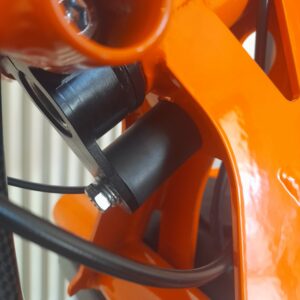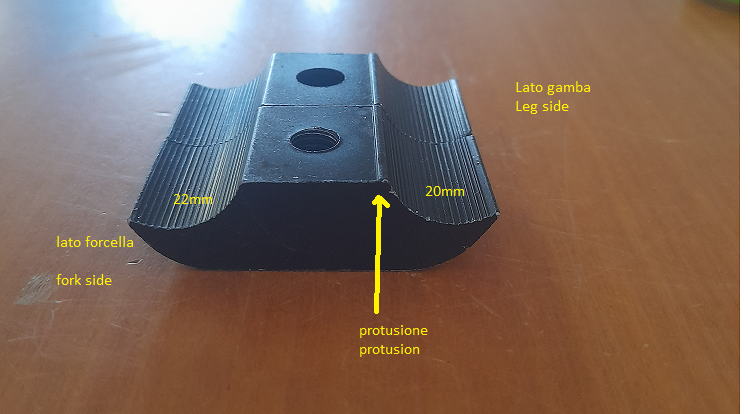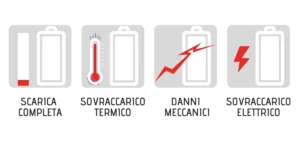SCRAMBLER USER MANUAL
rev1.1
Thank you for purchasing the Scrambler RS handbike.
We hope you will enjoy our handbike for a long time.
Before using the ScrambleR RS, take the time to read this manual entirely.
GENERAL WARNINGS ATTENTION!

Since it is impossible to predict every situation and condition that may arise while using a handbike, this manual makes no representations about the safe use of your Scrambler RS in all conditions. There are risks associated with the use of any cycle which cannot be foreseen or avoided and which are the sole responsibility of the rider.
Destination of use.
This velocipede is intended for use on dedicated marked tracks, with stable, compact ground, with suitable climatic conditions, floodlit, away from heavy traffic.
Not recommended use*
Not recommended for use in situations including but not limited to:
Areas of intense traffic, pedestrian areas, downhills, excessive slopes, terrains with unmanageable inclined planes, landslides or flooded terrains, excessive speed, children, use after improper repairs, use of unauthorized accessories, any unauthorized modifications or customizations.
*The manufacturer is not responsible for any damage to the velocipede and/or to people or things deriving from a non-recommended use.
Usage recommendations*
Use according to the highway code. Always wear suitable clothing and protections.
Do not immerse in water. Before use, check that it is in good general condition, as well as the condition of the brakes and pedal assistance system. Make sure that there are no obstacles in steering and that the wheels are intact in all their parts. Do not push into reverse without making sure that the wires to the grips are free or could become trapped. Make sure that the chain and the whole transmission are free and working even when empty. Make sure that there are no parts in contact with your body that could cause skin lesions. The standard cushion is not anti-decubitus, if necessary replace it with a cushion suitable for your safety. Do not lift the handbike by the rear wheels. Avoid snagging obstacles with the rear wheels and do not attempt to free yourself from rollover or block situations by levering them.
Always travel with someone. Do not wash with pressure washers, do not wash the battery. Before inserting the battery, make sure it is dry and intact in its seat. The battery is not shock resistant. Store the handbike in a dry place and protected from bad weather.
Do not leave the battery in damp and cold environments. Keep away from knocks and flammable substances. If you plan not to use the battery for long periods, make sure it is between 30% and 60% charged
During the movement it is necessary not to act abruptly on the steering, on pain of overturning. The counter slopes or inclined planes must be performed with skill and adequate speed, under penalty of overturning. Before using the Scrambler andbike over long distances, familiarize yourself with a place close to home. Adjust your speed to the situation, gain experience in driving, cornering and braking.
The Manufacturer is not responsible for any damage to the velocipede, to persons or things deriving from the improper use of the Scrambler.
index:
1) Whells
1.1front wheel
1.2 rear wheels
2) Brakes
2.1 Front brake
2.2 Rear Brakes
3) Shifter
4) Stear
5) Legs Supports
6) Assist pedal
7) Battery
8) Suspension
9) Warranty
—-
1) Whells
The stock wheels used on the Scrambler are commercial items modified in parts. Before buying other wheels, check their compatibility and/or the possibility of making them suitable.
Make sure that the wheels are intact and well fixed to the frame.
1.1 Front wheel
The rear wheel has a 148mm boost-type hub with a thru-axle. The diameter is from 27.5 The size of the cover may vary in width. Use suitable covers, consulting the construction specifications. Do not use widths larger than 2.6 inches.
Disassembly:
To disassemble the front wheel it is necessary to unscrew and extract the through pin. Then release the chain from the gear and extract the wheel from the fork.
Assembly:
To mount the wheel, first fit the chain, then insert the wheel into its seat, being careful to insert the brake disc correctly into the caliper. Then insert the pin and tighten the nut completely.
1.2 Rear Wheels
The rear wheels are modified 100 or 110 mm hub wheels with screw-type thru axles.
The diameter is from 27.5 The size of the cover may vary in width. Use suitable covers, consulting the construction specifications. Do not use widths greater than 2.8 inches.
Disassembly:
To disassemble the rear wheel it is necessary to unscrew and extract the through pin. Then release the wheel from the brake caliper and remove. Attention, Dirt could jam the pin in the wheel. Before completely unscrewing make sure that the pin is free. If it is not, it could pull the wheel behind it with the disc still in the brake caliper seat. To release the hub from the pin, tap around the hub. Knocking means blows given by hand or with an object suitable for not damaging the wheel.
Assembly:
To mount the wheel, first fit the chain, then insert the wheel into its seat, being careful to insert the brake disc correctly into the caliper. Then insert the pin and tighten the nut completely.
2) Brakes
ATTENTION! IMPROPER MANEUVERS COULD ROLL THE BRAKE CABLES AND HOSES ONTO THE CRANKS AND DAMAGE THEM! The parking brake consists of an elastic band or velcro, positioned on the knobs. When it is necessary to lock the handbike, use the elastic or Velcro to keep the lever pressed.
IMPORTANT! brake levers and hoses are moving parts, which leads to unpredictable wear. Check the integrity of the tubes before use. If damage occurs, go to a specialized center for repair.
2.1 Front brake
The front brake is a 203mm disc brake with hydraulic system. Before use Make sure that the system is functional and undamaged. If a repair is required, you can go to a cycle repair center and ask for intervention. If repairs are not possible, the entire system must be replaced by purchasing a rear right bicycle kit with a minimum tube length of 1700 mm. It is advisable to purchase a quality kit and in any case suitable for the type of use of the handbike. Products that are too substandard could endanger your safety and that of others.
2.2 Rear Brakes
Rear braking is equipped with two 180 mm hydraulic discs. Before use Make sure that the system is functional and undamaged. If a repair is required, you can go to a cycle repair center and ask for intervention. We recommend the use of quality spare parts and in any case suitable for the type of use of the handbike. Products that are too substandard could endanger your safety and that of others.
—
3) Shifter
WARNING! While driving, the shift cable moves near the grips. Over time, these oscillations damage the control wiring. Periodic replacement of the wire and sheath will therefore be necessary. If you are unable to carry out the repair or replacement, just go to a cyclist and ask to carry out the repair as on a normal bicycle
The front wheel derailleur is a bicycle (rear) shifting system. Varies Depending on the models and years of production. Refer to the manufacturer's manuals.
—
4) Stear
The steering system is entrusted to a structure similar to that of a bicycle. The headset is a common 1″ 1/8 ahead spare. The return to the steering center is guaranteed by a 40×30 mm female female 8Ma anti-vibration rubber.

To adjust the steering drift, loosen the screw with a #13 hex key, adjust the steering and tighten the screw. Make sure that the screws are well tightened and that the rubber is intact. Periodically check the state of wear of the steering rubber and if necessary replace it with one of the same type.
5) Legs Supports
ATTENTION! MAKE SURE THAT THE LEG SUPPORTS ARE INTACT AND FIRMLY FIXED.
The adjustment of the leg supports is very subjective. Once you have found the most suitable position for you, you can remove the excess pipe. Check that the leg support tubes do not injure your skin. The pressure from the hose clamps could attack the paint.
IMPORTANT! The clamps that support the leg supports have different diameters; 20mm on the leg support side and 22mm on the fork side. If you completely disassemble the system, be sure to reposition the clamp correctly, otherwise the support will not hold tight

IMPORTANT! Before each use, check that the clamps are well tightened.
—
6) Assist pedal
Velocipedes are vehicles with two or more wheels propelled exclusively by muscles, by means of pedals or similar devices, operated by the people who are on the vehicle; pedal assisted bicycles are also considered velocipedes, equipped with an auxiliary electric motor having a maximum continuous rated power of 0.25 kW, the power of which is progressively reduced and finally cut off when the vehicle reaches 25 km/h or sooner if the cyclist stops ride."
The assisted pedaling is provided by a 250W 36v motor at the bottom bracket as required by law. For the user manuals, refer to the information given by the specific manufacturer.
—
7) Battery
The batteries are of the lithium ion type, and therefore adequate caution must be exercised and the usual rules of storage, use and transport of such objects must be followed. There is no need to worry about completely discharging your battery as the pedal assistance system is equipped with a "cut-off" which cuts off the current absorption from the battery below a charge threshold.


Usare con cautela e smaltire a norma di legge.
—
8) Suspension
The rear suspension system is of the torsion beam type. It is entrusted to two 190 mm shock absorbers. For it to work properly it needs to be calibrated to the person. For weight adjustment it is recommended that there is a lunge with the rider of about 2 cm. Also adjust the rebound (where present) according to the courses. We leave the conductor free will to choose the preferred setting.
—
9) Warranty
The legal guarantee has a duration of 2 years on all components excluding parts subject to wear. Tampering with any part immediately voids the guarantee.
—
Never dispose of in household waste. Dispose of at an appropriate reclamation facility
